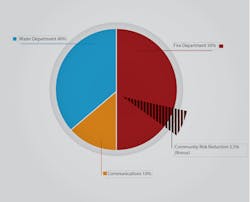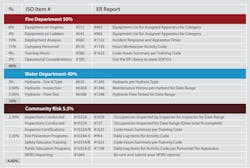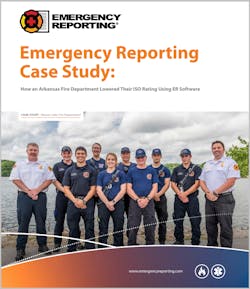Industry Expert Blog: Improving Your ISO Score with Fire/EMS Records Management Software
ISO Audits: Preparation is Key
When the Insurance Services Office (ISO) is coming to town, it typically means a fire department can spend hundreds of valuable man-hours to prepare for the visit. Anyone who has had a successful ISO audit will agree that being well-prepared is vital – but that preparation doesn’t have to be overly stressful and time-consuming.
Using a powerful Records Management Software (RMS) platform like Emergency Reporting (ER) is one of the best ways to be prepared for your next ISO audit. In this blog we’ll discuss ways to use your RMS to help you prepare (and stress less), and even improve your department’s rating. We’ll give you an inside look at how on ER customer, Administration Major David Richardson of Midwest City Fire Department in Oklahoma, led his department through three ISO audits and successfully used ER to achieve a top ISO Class 1 each time.
Not only has Major Richardson led his department through several successful ISO audits, but he was also an ISO rep for seven years prior to working in the fire service. His valuable advice can help you prepare for your next ISO survey.
To view the full white paper click here.
ISO Public Protection Survey: The Basics
ISO inspections or audits are conducted by field representatives who visit a community to determine the fire risk based on the Field Suppression Rating Schedule (FSRS). Using the FSRS, ISO will evaluate many facets of your community’s fire suppression and prevention efforts. Upon completion of their assessment, ISO will issue the audited department a Public Protection Classification (PPC) rating from 1 to 10, with 1 being the best.
Every property owner with insurance in the United States can be affected by a community ISO Public Protection Classification rating. A department can often help reduce their community’s insurance premiums by improving their PPC. A lower PPC not only results in lower insurance premiums, it also reduces the fire risk to people and property. There are four areas that ISO will grade you on: Fire Department – 50%, Water Department – 40%, Communications –10%, and Community Risk Reduction – 5.5% (bonus points).
Breaking Down the ISO Evaluation + ER Reports That Will Come in Handy
Below is a useful chart, created by Major Richardson, that shows ISO item numbers from three of the grading categories, and the correlating ER reports to use. Sixty percent of your grading can be done with these reports in ER:
Let’s take a closer look at the fourth item as an example. This is in the Fire Department category – which accounts for fifty percent of the ISO assessment. Fire department personnel (ISO item #570) makes up 15 percent of that 50. In other words, fire department staffing is 7.5 percent of the entire ISO score.
ER can help departments prepare for this portion of the assessment by enabling them to account for the number of Existing Company Personnel (ECP). A component of the ECP is the number of On-Duty Firefighters at Fire Stations (ODF). This number is the average number of firefighters on-duty with companies at the fire stations. A volunteer or combination department can also earn credit for firefighters that spend time at the station. Any volunteer firefighter doing activities at a station where he/she can respond to incidents should log those hours with a code you can easily reference when running ER Report #1299.
For more specific information about how ER helped an Arkansas department lower their ISO rating check out, Emergency Reporting Case Study: How an Arkansas Fire Department Lowered Their ISO Rating Using ER Software.
Preparing for Your Next ISO Audit
Major Richardson advises that the number one most important thing you can do to prepare is to ensure you are regularly and accurately submitting your data, and to have a person or a team of people who monitor it regularly. For example, Richardson says, ER report #1722 in the Incidents module gives you all the data needed for 1710 response times for ISO use. ER report #1623 is the best report to summarize your annual records and is extremely helpful to the ISO rep. “All of those in some form have an impact on the data that I’m going to give an ISO field rep when he comes. All of these will help provide the data that ISO’s looking for,” he says.
According to Richardson, the report that works best for keeping track of personnel in ER is #1193 in the Daily Roster – which he says is extremely important. “Log your time and make sure you show all your manned hours. If you don’t do the work, you lose points,” he says. “If you can show actual staffing (down to the decimal), it can benefit you greatly. Personnel is the single highest point item in the entire FSRS.”
Whether your agency has been through several ISO audits or hasn’t had one yet, it’s important to make sure you’re accurately and consistently inputting and monitoring your data, as well as taking advantage of your software in preparation for a future ISO visit. As Major Richardson puts it: “Just having a RMS and your records will get you points.”
To learn more about how to use ER data for your next ISO Public Protection Survey, watch the ER webinar led by Major Richardson:If you think Emergency Reporting could help with your next ISO visit sign up for a free trial.
About Emergency Reporting
Emergency Reporting (ER) offers a powerful, cloud-based records management software (RMS) solution to Fire/EMS agencies worldwide. Founded in 2003, ER empowers first responders with secure, easy-to-use station management tools that offer one-report filing of NFIRS and NEMSIS data. ER’s affordable SaaS solution allows Fire/EMS departments to run their entire operations efficiently and effectively, enhancing both firefighter and citizen safety. ER is proud to support more than 460,000 first responders at thousands of civilian Fire/Rescue and EMS agencies and DoD/military installations, as well as large entities with self-contained Fire/EMS services such as NASA, nuclear power plants, hospitals, and oil refineries. For more information, visit www.emergencyreporting.com.
Author description:
Emergency Reporting (ER) offers a cloud-based records management software (RMS) solution to Fire/EMS agencies worldwide. Founded in 2003, ER empowers first responders with secure, easy-to-use station management tools that offer one-report filing of NFIRS and NEMSIS data. ER’s SaaS solution allows Fire/EMS departments to run their entire operations efficiently, enhancing both firefighter and citizen safety. The company’s training and support teams, with 220+ years of combined Fire & EMS experience, help ER maintain its reputation as the most friendly and easy-to-use RMS solution on the market. ER is proud to support more than 460,000 first responders and agency personnel at more than 6,140 agencies, continuously adding an average of 18 new agencies each week. Current customers include Fire/Rescue and EMS agencies and DoD/military installations, as well as large entities with self-contained Fire/EMS services such as NASA, nuclear power plants, hospitals, and oil refineries. For more information, visit www.emergencyreporting.com.










